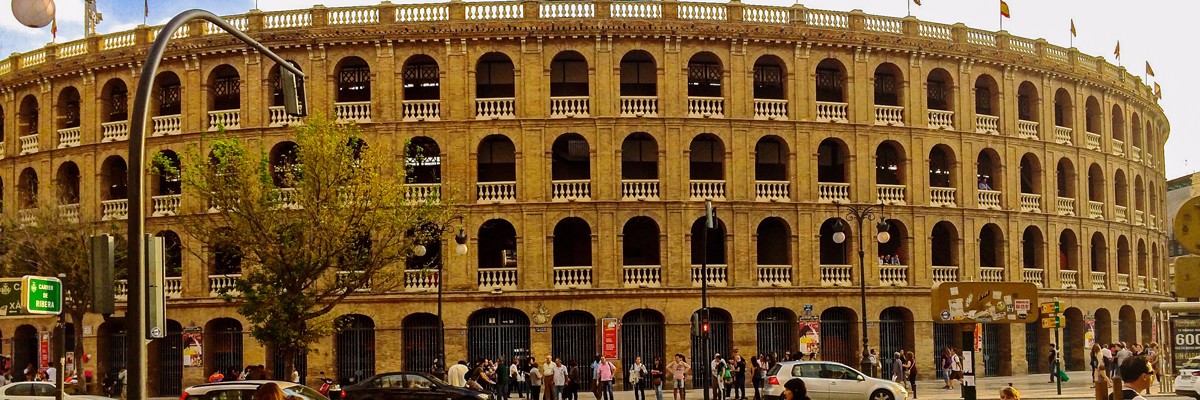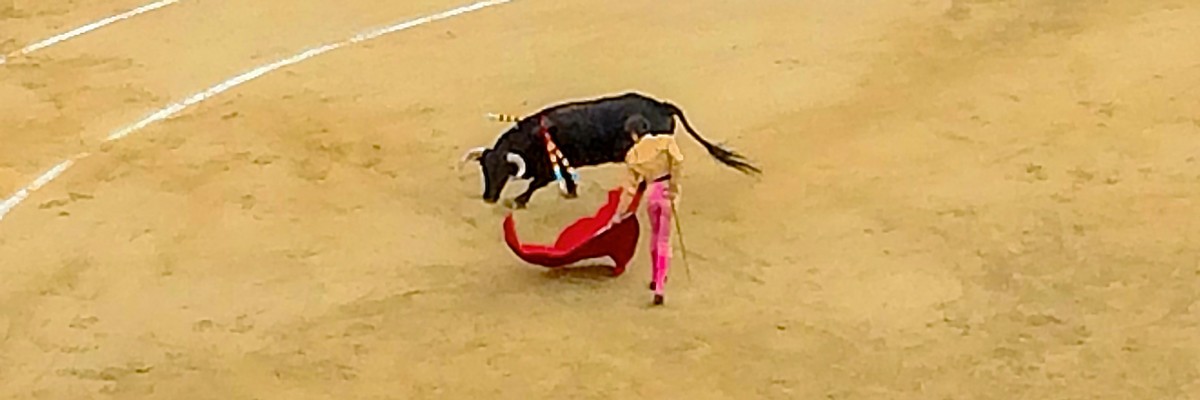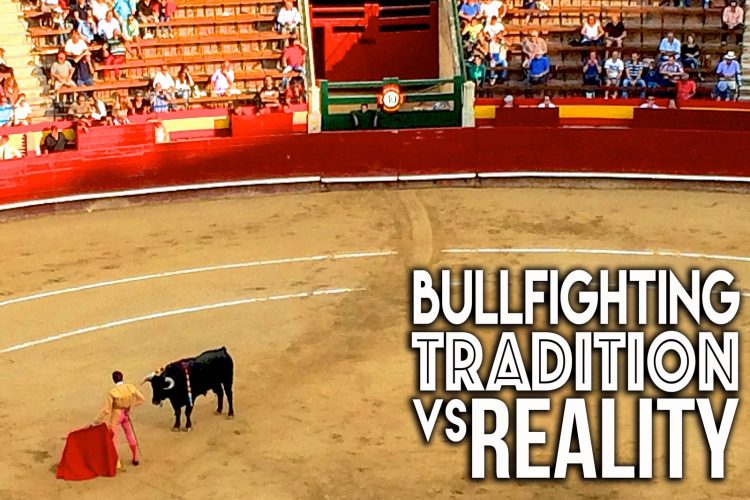The dates worked out, so we just couldn’t miss Valencia Bullfighting at Plaza de Toro.
Truly, I’ve always found the idea of a bullfight alluring, most definitely bucket-list material. Although, bullfighting has been highly criticized for brutality, and is currently endangered of extinction as cities around the world have banned the sport. So we attended Valencia Bullfighting, our first and possibly only bullfight, learning more about the sport’s tradition and the reality of it all.
The Tradition of Bullfighting:

The first bullfights were recorded as early as the 700’s, with nobility fighting bulls from horseback… Eventually deemed too brutal for the ruling class, the sport evolved into what we see today and has been fought on foot since 1726.
Wikipedia gives a pretty thorough description of the ceremony:
Spanish-style bullfighting is called corrida de toros (literally “running of bulls”) or la fiesta (“the festival”). In the traditional corrida, three matadores, each fight two bulls, each of which is between four and six years old and weighs no less than 460 kg (1,014 lb)[10] Each matador has six assistants—twopicadores (“lancers on horseback”) mounted on horseback, three banderilleros – who along with the matadors are collectively known as toreros(“bullfighters”) – and a mozo de espadas (“sword page”). Collectively they comprise a cuadrilla (“entourage”). In Spanish the more general torero is used for the lead fighter, and only when needed to distinguish a man is the full title matador de toros used; in English, “matador” is generally used for the bullfighter.
The modern corrida is highly ritualized, with three distinct stages or tercios (“thirds”); the start of each being announced by a bugle sound. The participants enter the arena in a parade, called the paseíllo, to salute the presiding dignitary, accompanied by band music. Torero costumes are inspired by 17th-century Andalusian clothing, and matadores are easily distinguished by the gold of their traje de luces (“suit of lights”), as opposed to the lesser banderilleros, who are also known as toreros de plata (“bullfighters of silver”).
Next, the bull is released into the ring, where he is tested for ferocity by the matador and banderilleros with the magenta and gold capote (“cape”). This is the first stage, the tercio de varas (“the lancing third”). The matador confronts the bull with the capote, performing a series of passes and observing the behavior and quirks of the bull.
Next, a picador enters the arena on horseback armed with a vara (lance). To protect the horse from the bull’s horns, the animal wears a protective, padded covering called peto. Prior to 1930, the horses did not wear any protection. Often the bull would disembowel the horse during this stage. Until the use of protection was instituted, the number of horses killed during a fiesta generally exceeded the number of bulls killed.[11]
At this point, the picador stabs just behind the morrillo, a mound of muscle on the fighting bull’s neck, weakening the neck muscles and leading to the animal’s first loss of blood. The manner in which the bull charges the horse provides important clues to the matador about which side the bull favors. If the picador is successful, the bull will hold its head and horns slightly lower during the following stages of the fight. This ultimately enables the matador to perform the killing thrust later in the performance. The encounter with the picador often fundamentally changes the behaviour of a bull; distracted and unengaging bulls will become more focused and stay on a single target instead of charging at everything that moves.
In the next stage, the tercio de banderillas (“the third of banderillas”), each of the three banderilleros attempts to plant two banderillas, sharp barbed sticks, into the bull’s shoulders. These anger and agitate, but further weaken, the bull. He tires from his attacks on the horse and the damage he has taken from the lance. Sometimes a matador will place his own banderillas. If so, he usually embellishes this part of his performance and employs more varied manoeuvres than the standard al cuarteo method commonly used by banderilleros.
In the final stage, the tercio de muerte (“the third of death”), the matador re-enters the ring alone with a small red cape, or muleta, and a sword. It is a common misconception that the color red is supposed to anger the bull; the animals are colorblind.[12][13] The cape is thought to be red to mask the bull’s blood, although the color is now a matter of tradition. The matador uses his cape to attract the bull in a series of passes, which serve the dual purpose of wearing the animal down for the kill and creating an interesting display, or faena. He may also demonstrate his domination of the bull by caping and bringing it especially close to his body. The faena refers to the entire performance with the cape (muleta).
It is usually broken down into tandas, or “series”, of passes. The series (tanda) ends with a final series of passes in which the matador, using the cape, tries to maneuver the bull into a position to stab it between the shoulder blades and through the aorta or heart. The sword is called estoque, and the act of thrusting the sword is called an estocada. During the initial series, while the matador in part is performing for the crowd, he uses a fake sword (estoque simulado). This is made of wood or aluminum, making it lighter and much easier to handle. The estoque de verdad (real sword) is made out of steel. At the end of the tercio de muerte, when the matador has finished his faena, he will change swords to take up the steel one. He performs the estocada and kills the bull with a pierce through the heart, if all goes according to plan. Many times the bull does not get pierced through the heart during the estocada initially, and repeated efforts must be made to bring the bull down and end his life.
If the matador has performed particularly well, the crowd may petition the president by waving white handkerchiefs to award the matador an ear of the bull. If his performance was exceptional, the president will award two ears. In certain more rural rings, the practice includes award of the bull’s tail. Very rarely, if the public or the matador believe that the bull has fought extremely bravely, the event’s president may be petitioned to grant the bull a pardon (indulto). If the indulto is granted, the bull’s life is spared; it leaves the ring alive and is returned to its home ranch. There the bull becomes a stud for the rest of his life.
Reality: Krissy’s Recap of Valencia Bullfighting:

- Mess with the bull’s head by taunting him on every side of the ring with pink capes.
- Have a guy on a blindfolded horse jab him with a gig a few times.
- Insert Six-ish daggers into the bull’s back. At this point the bull is bloody and getting weak.
- Send in the main matador to run the bull around and get him even more tired. (Take water break)
- Insert a full-length sword in bull’s back.
- Mess with bull’s head for a bit more while sword is still fully inserted.
- Bull falls down, insert small yet affective knife into bull’s head.
- Blindfolded horse drags away the dead bull.
- Matador slowly walks perimeter of ring to receive applause from crowd.
- Done. Next bull please!?


One Response to “Valencia Bullfighting: Tradition vs. Reality”
Mama Jan
I think Krissy’s look says it all. Ha!